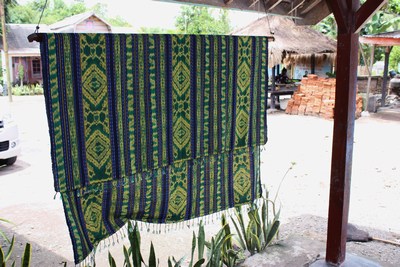 Everyone who visits Bali inevitably leaves with one kind of souvenir; it could be a T-shirt or some strange looking phallic symbol. However, for that special souvenir, and one that is everlasting, look at the options of purchasing a piece of textile. I don’t mean your wrap-around sarong but a hand-woven or loom created piece.
Everyone who visits Bali inevitably leaves with one kind of souvenir; it could be a T-shirt or some strange looking phallic symbol. However, for that special souvenir, and one that is everlasting, look at the options of purchasing a piece of textile. I don’t mean your wrap-around sarong but a hand-woven or loom created piece.
Don’t restrict your choice of textile to just Bali. Seek out those pieces made in Java, Lombok or Sumbawa. In fact, on the island you will be able to find quite a few of these pieces. Indonesians are renowned the world over for their textiles. Balinese traditional textiles are much more than simply decorative pieces of cloth. In Bali, the Balinese produce textiles for a variety of markets and, one of them the tourist trade.
Various forms of cloth are produced on the island of Bali and each one beautiful in its own right. Batik is a textile is manufactured mainly in factories these days but there are some smaller places in the outer lying villages where the batik process is still as it has been for centuries.
The two main styles of Batik are batik tulis and batik cap. The art of Balinese textile decoration is best expressed in skirt, chest and head cloths. There are three main categories of Balinese textile and these are Prada, Songket and Ikat.
The main batik manufacturing town on Bali is at Gianyar where many factories can be found and visited. Be warned though, the price you pay at the factory is inflated and you would be better of checking the street prices in markets such as Sukawati first. Be warned though that purchasing traditional cloth in the markets along the tourist strip will not give you the quality you will find in the places of origin. There are other traditional weavers in other places across Bali that weave stunning pieces of cloth and it is to these places you should visit.
Grinsing is one of the rarest weaving techniques practiced and you will find this textile in the traditional village of Tenganan, East Bali. Gringsing is also known as the ‘flame cloth’ and in this elaborate dyeing process both the warp and weft threads are carefully bound before dyeing. This creates numerous patterns that once finished seemingly fit together perfectly and harmoniously.
Tenganan is the only place in the world where the double-ikat process is practised. There are not many women left in Tenganan who know this practice of weaving but it is being handed down to the next generation. To weave a piece of gringsing could take up to three days but the finished product is superb. When you visit the village you are welcome to have a look at this weaving process and of course for a fee!.
Endek is a tie-dyed woven textile popular with most Balinese. Wooden hand-operated looms are used in the process of the weft-ikat method. This is where sections of the cloth are tied and then wrapped before immersing them into tubs of dye. The basic designs are irregular and soft wavy patterns. Also created are diamond designs and a zigzagging pattern. Endek is a versatile cloth for the Balinese because it can be worn for both daily use and ceremonial purposes.
Songket is a brocaded silk that has interweaving patterns of silver and gold thread and is classified as the ceremonial dress of all Balinese. Worn mainly on religious occasions, it is also worn to weddings, tooth filings and other important ritual events. The cloth is tapestry in appearance and has various motifs including wayang figures, birds, butterflies, flowers and leaves. The process of weaving is done on back-strap looms. Because of its thread and quality it is generally accepted that it is a wealthy man’s cloth.
Interestingly, the kain songket is bought in two pieces and then sewn together. The men wear the songket saput. This is a narrow piece of cloth worn over a sarung. Together with a songket udeng or head band this is for more formal and ceremonial occasions.
Decorated with silver or gold thread, kain prada is a lustrous fabric woven of cotton or silk. A ceremonial cloth, it is generally two meters in length and can take up as long as three months to weave from start to finish. Various patterns include lotus blossoms with swastikas as border decorations. These are however the most common motifs.